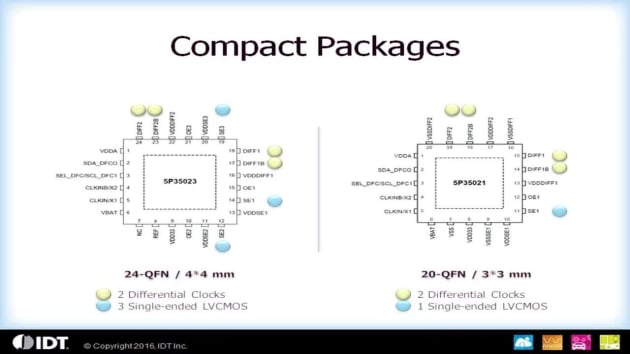特長
- OE、PD#、PPS、DFCの制御機能としてOEピンの機能を設定可能
- PLL帯域幅の設定可能/ジッタピーキングの最小化
- PPS:エンドデバイスのパワーダウン・モード時に電力を節約するプロアクティブ省電力機能
- PPB:Performance- Power Balancing機能により、必要な性能に応じた最小限の電力消費を実現
- DFC:Dynamic Frequency Control機能により、最大4つの異なる周波数をダイナミックに切り替え可能
- スペクトラム拡散クロックに対応し、システムEMIの低減を実現
- I2Cインタフェース
-
水晶振動器の入力にも対応
-
AEC-Q100準拠、グレード2(-40℃〜+105℃)バージョンで利用可能
説明
カスタムプログラムユーティリティをお試しください。
パラメータ
| 属性 | 値 |
|---|---|
| Outputs (#) | 7 |
| Output Type | LVCMOS, LVPECL, LP-HCSL, LVDS |
| Output Freq Range (MHz) | 0.032768 - 500 |
| Input Freq (MHz) | 1 - 160 |
| Inputs (#) | 1 |
| Input Type | Crystal, LVCMOS, LVPECL, LVDS, LP-HCSL |
| Phase Jitter Typ RMS (ps) | 3 |
| Output Banks (#) | 5 |
| Core Voltage (V) | 3.3 |
| Output Voltage (V) | 1.8V, 2.5V, 3.3V |
パッケージオプション
| Pkg. Type | Pkg. Dimensions (mm) | Lead Count (#) | Pitch (mm) |
|---|---|---|---|
| VFQFPN | 4.0 x 4.0 x 0.9 | 24 | 0.5 |
製品比較
| 5P35023 | 5L35021 | 5L35023 | 5P35021 | |
| Outputs (#) | 7 | 5 | 7 | 5 |
| Output Type | LP-HCSL, LVCMOS, LVDS, LVPECL | LP-HCSL, LVCMOS | LP-HCSL, LVCMOS | LP-HCSL, LVCMOS, LVDS, LVPECL |
| Core Voltage (V) | 3.3 | 1.8 | 1.8 | 3.3 |
| Output Voltage (V) | 1.8, 2.5, 3.3 | 1.8 | 1.8 | 1.8, 2.5, 3.3 |
| Pkg. Dimensions (mm) | 4.0 x 4.0 x 0.9 | 3.0 x 3.0 x 1.0 | 4.0 x 4.0 x 0.9 | 3.0 x 3.0 x 1.0 |
アプリケーション・ブロック図

|
ペット監視用カメラロボット
リアルタイムの映像、音声、ワイヤレスコントロールが可能なモバイルペット監視用カメラロボット。
|

|
高性能な集中制御式サーモスタットシステム
集中制御式サーモスタットシステムは、複数のサーモスタットを統合し、スマートな空調制御と効率化を実現します。
|

|
AI機能付きビデオ会議カメラ
デュアルカメラとビームフォーミングオーディオを搭載したAI搭載360°ビデオ会議システム。
|

|
ハイエンドの機能豊富なHMIプラットフォーム
ディスプレイ解像度、オーディオ、スピーカなどの豊富な機能をサポートする柔軟なHMIプラットフォーム。
|

|
シングルボードコンピュータゲートウェイ
Arm Cortex-A55およびArm Cortex-M33コアを搭載したSBCゲートウェイは、効率的な処理、柔軟性、および接続性を提供します。
|

|
AI物体検出とモーションセンシングを備えたバッテリ駆動カメラ
効率的なモーション検出、高速起動、低電力のオブジェクト分類を実現するAI搭載のバッテリ駆動カメラ。
|

|
NFC、カメラ、静電容量式タッチ認証を備えたアクセス制御システム
アクセス制御システムは、NFC、Wi-Fi、PoE、ローカルストレージ、および柔軟なOSサポートにより、セキュリティを確保します。
|

|
コンピュータビジョン用システムオンモジュール(SoM)
ルネサスのSoMは、AI、コスト効率、シームレスなSMARC 2.1統合により、コンピュータビジョンを強化します。
|

|
モバイルPOS(Point of Sale)端末
安全なワイヤレスのマルチペイメントをサポートするモバイルPOSで、どこでもシームレスな取引が可能です。
|

|
MPUベースのシングルボードコンピュータ
Linuxサポート、ワイヤレス接続、組み込みアプリケーション向けのコンパクトなフォームファクタを備えたSBC。
|

|
Bluetooth Low Energyメッシュ用ネットワークゲートウェイ
デュアルコアMPU、Bluetooth LEメッシュ、Wi-Fi、ローカル/クラウドストレージ、アラーム、セキュア通信を備えたゲートウェイ設計。
|

|
RISC-V MPU を搭載したスケーラブルな SMARC 2.1 ゲートウェイ SoM
IIoTゲートウェイ向けのスケーラブルなSMARC 2.1 SoM設計は、低消費電力、強力な接続性、柔軟性を備えています。
|

|
RTOSベースのRZ/A3UL HMI SMARC SoM
スマートビルディングでの低電力およびリアルタイムHMI制御に最適化された電力を備えたSOM。
|

|
将来のE/Eアーキテクチャのための車載コンピュータ
高度なE/Eアーキテクチャを高い計算能力で実現する次世代車載コンピュータシステム。
|

|
シングルコアArm Cortex-A55 MPU用SMARCシステム
Arm Cortex-A55 MPUを搭載したAI対応SMARC SoMにより、低消費電力のHMIおよび産業用制御を実現します。
|
フィルター
ソフトウェア/ツール
サンプルコード
シミュレーションモデル
This video introduces IDT's VersaClock 3S Programmable Clock Generators, known for their innovative power-saving features and compact design that eliminates multiple timing components. Designed for applications in consumer, industrial, computing, and automotive sectors, these devices offer low power consumption and low jitter scalability, meeting PCI Express® Gen 1/2/3 standards.
Key features highlighted include Proactive Power Saving, Performance-Power Balancing, Dynamic Frequency Control, and Overshoot Reduction Technology. The video showcases the VersaClock 3S models, including the 5P35023 with multiple outputs and the 5P35021 with a 32.768KHz clock for RTC reference, supported by IDT's Timing Commander software for easy programming.
The VersaClock 3S devices deliver innovative power-saving features while saving board space by eliminating the need for multiple discrete timing components. Delivering low power and low jitter scalability, the VersaClock 3S devices meet requirements for widely used standards including PCI Express® Gen 1/2/3, and are ideal for consumer, industrial, computing, and automotive applications.
The 5P35023 and 5P35021 chips deliver a unique set of features offering an optimal combination of performance, power, and flexibility.
Description
IDT's innovative support tool, Timing Commander™, expedites development cycles by empowering customers to program sophisticated timing devices with an intuitive and flexible Graphical User Interface. IDT's Timing Commander is a Windows™-based platform designed to serve user-friendly configuration interfaces, known as personalities, for various IDT products and product families. With a few simple clicks, the user is presented with a comprehensive, interactive block diagram offering the ability to modify desired input values, output values, and other configuration settings. The software automatically makes calculations, reports status monitors, and prepares register settings without the need to reference a datasheet. The tool also automatically loads the configuration settings over USB to an IDT evaluation board for immediate application in the circuit. Once the device has been configured and tuned for optimal system performance, the configuration file can be saved for factory-level programming before shipment. For more information about Timing Commander, visit our Timing Commander page.
Resources
IDT provides a brief overview of the timing solutions optimized for various configurations using the NXP (Freescale) QorIQ / Layerscape processors.
Resources
IDT provides a brief tutorial on the timing solutions required for NXP (Freescale) QorIQ / Layerscape processor-based systems.
Presented by Ron Wade, PCI Express timing expert.

